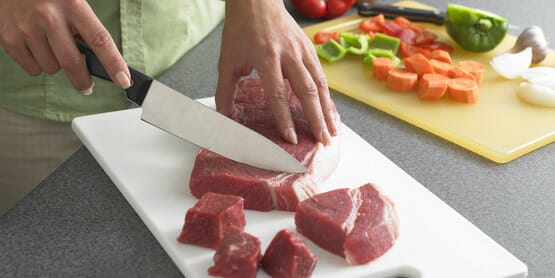Some people misconstrue “renal diet” to be a type of vegetarian or vegan diet, since they are told to control their protein intake.
However, you don’t have to entirely eliminate meat from your intake. You just have to choose the right kind of meat.

List of Renal Diet Meats
The following is a list of meats for your renal diet. Note that these still need to be properly portioned to avoid going overboard with your protein limits. Consult your healthcare providers and/or dietitian.
Like this list? There’s more foods available in our official food list for CKD patients. Check them out!
But Wait a Minute…?
Aren’t I supposed to stay away from beef, and pork, and these other meats?
You might be thinking that way, of course. However, like what I said, it’s all about portioning. Look at how big your meat portion should be:
And it’s not only your protein intake that you should learn to portion. Click here to see how you can portion your foods on a renal diet.
Calculating Your Limits
You also have to note how much protein you can take in a day. The current recommended limit for those on pre-dialysis diet is about 37-41 grams of protein per day, but this is still subject to limits set by your nephrologist.
There’s also a way to calculate your protein intake based on your body weight. In the case of pre-dialysis (CKD Stages 1-4), you’ll need between 0.6 - 0.8 grams of protein per kilogram of body weight.
So, for example:
Jane weighs about 132 pounds. To get her approximate weight in kilograms, let’s divide her weight by 2.2, so…
132 lbs ÷ 2.2 = 60 kg
Now that we have her body mass, let’s see how much protein she’s allowed daily by multiplying her body mass with the limits indicated above:
60 kg × 0.6 g/kg = 36 grams
60 kg × 0.8 g/kg = 48 grams
That means Jane is only allowed about 36-48 grams of protein daily.
BONUS MATERIAL:
Here’s how much protein common foods (animal-based) have, in grams per serving size:
FOOD ITEM | SERVING SIZE | PROTEIN |
|---|---|---|
Chicken (light meat, no skin, cooked) | 3 oz | 26.3 g |
Pork roast, cooked | 3 oz | 23.9 g |
Chicken (dark meat, cooked) | 3 oz | 23.3 g |
Beef (round steak, cooked) | 3 oz | 22.6 g |
Cheddar cheese | 3 oz | 21.1 g |
Cottage cheese, low fat | 1/2 cup | 15.6 g |
Milk, skim | 1 cup | 8.4 g |
Egg | 1 pc | 6.3 g |
Protein and the Body
http://pods.dasnr.okstate.edu/docushare/dsweb/Get/Document-2473/T-3163web.pdf
Protein and the Body - Dr. Janice Hermann, Nutrition Specialist - Oklahoma State University:
http://pods.dasnr.okstate.edu/docushare/dsweb/Get/Document-2473/T-3163web.pdf
Dietary protein for the person with chronic kidney disease - The Nephron Information Center
http://nephron.org/nephsites/adp/protein_ckd.html

